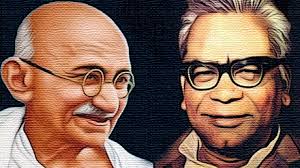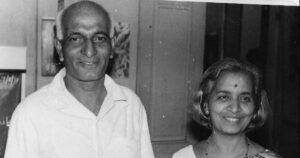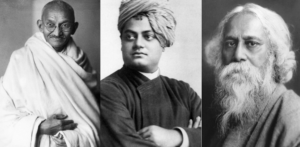Prem Singh
Lohia’s critique of Gandhiji has been a significant contribution to Gandhian studies in the post-Gandhi era. Lohia as a heretic Gandhian makes perhaps the most revolutionary interpretation of Gandhiji’s philosophy and modes of action. He left incomplete his long essay “Economics After Marx”, that he had begun in 1943–44 (the essay is compiled in Marx, Gandhi and Socialism), but later took fresh initiatives for the construction of his own kind of socialist philosophy and politics. In his construction, or to use his own word “integration”, of the new philosophy he found more useful material in the ideas, life and actions of Gandhiji. According to him, the new socialist philosophy, opposed to communism and capitalism both, will be the basis of a new civilisation. Lohia accepted the fact that he was influenced by the great personality of Gandhiji but was never blinded, intimidated or sentimental about it. After keeping Marx aside he embarks upon a serious interpretation of Gandhiji. Lohia’s interpretation of Gandhiji is an integral part of his serious philosophical venture. But at the same time it is not aimed at proposing some sort of a separate creed of Gandhism.
In Indian politics Lohia is known as a socialist thinker and leader. His intellectual and political activism was aimed at socialist revolution in India as well as in the rest of the world. He wrote in this connection, “Capitalism and communism are almost fully elaborated systems, and the whole world is in their grip, the result is poverty and war and fear. The third idea is also making itself felt on the world stage. It is still inadequate, and it has not been fully elaborated, but it is open. In an open system there is still some chance of truth and progress, while a closed system does violence to facts and wishes them away in order to prove their meaninglessness. Open systems live in accordance with the facts, and in any case we expect such systems to revitalise themselves with obstinate or changing situations. This idea is the socialist idea.” (18)
It is obvious that in the twentieth century, the idea of socialist revolution is mainly linked to Karl Marx. Lohia accepted the place of Marx in his tradition but at the same time he said “this talk of being a Marxist or an anti-Marxist is futile and irrelevant. What is relevant is correct thinking and integrated approach. Our mind must be on a quest, a quest for the essence that lies under Gandhiji’s or Marx’s thoughts. Quest and not entanglement with tradition can help us to do this.” (19) There is a prevalent belief that Lohia tries to mix Gandhi and Marx. Lohia himself refuted this : “Socialism need not proclaim itself as Gandhian or Marxist on the one hand and as anti-Gandhian or anti-Marxist on the other, for this would only substitute thought by a charm.” (20) It is not possible to present a detailed description of Lohia’s doctrine of socialism but here it is important to mention that it is a left doctrine; it is rooted basically in the Indian and Asian situations; it is committed to “leftism from below” instead of “leftism from top”; and to make it viable, Lohia proposed a package of “seven revolutions”.
Lohia was not a Gandhian of the Marxist blend, nor a Marxist of the Gandhian variety, but an individual thinker in his own right. Besides Gandhi and Marx, Lohia made it a point to give due consideration to other thinkers and philosophers. He also seriously tried to understand ancient Indian philosophy, concepts, myths and symbols. Only after a serious contemplation of all this did he embark upon his ideas about the “new integrations” required in the making of a new civilisation: “Nevertheless, as between a person who is arrogantly and pompously an adherent of any existing philosophy and another who has gone through the gamut of all philosophies and has come to the stage when he rejects them outright, I would prefer the latter, if it were the singular good luck of anybody to achieve a still newer integration, there could be nothing better.” (21)
In this way, Lohia broke the myth of dogmatic commitment to a particular philosophy or ideology and at the same time also broke the myth of the purity and originality of a particular philosophy or ideology. He wrote, “it is not the fault of Marx that people stay put at Marxism.” Lohia criticises the Gandhians in a similar manner : “The Gandhi doctrine has proved a little more inadequate. It will be countered that what prevails in the country today is not the Gandhi doctrine but a somewhat inferior brew of Gandhism and Marxism. That is substantially correct, but it confirms the weakness of Gandhism in so far as Marxism forces it to mix and also that the best in it is unable to burst forth.” (22) He spoke of two types of Gandhism after Gandhiji’s death: governmental Gandhism (sarkari gandhivad) and monastic or priestly Gandhism (mathi gandhivad). In the first category come Gandhiji’s political successors and in the second one, the lot engaged in various institutions, established in the name of Gandhiji and funded by the government. Lohia found them both ineffectual: “These governmental and monastic wings together comprise what is authoritatively accepted as Gandhism…. Authoritative Gandhism has proved after victory to be a mousy doctrine. All its teeth are out, giving rise to the doubt if it ever had any. Monastic Gandhism is wholly dependent for its being on governmental Gandhism. Governmental Gandhism does nothing except to chase the pale shadow of limited public sector planning. Both live a merry, contented, smug life, not devoid of luxury of a hierarchic kind.” (23)
It can be argued that despite influences coming from various sources, Lohia was closest to Gandhiji. Lohia did not reject Gandhiji’s ideas on truth, time, history, progress and development like the Marxists and capitalists. Gandhiji’s vision of life was cyclic. Lohia also talked of the “cyclic view of history.” (24) In the modern civilisation the linear view of the driving forces of history has come to be accepted as the gospel truth. Gandhiji and Lohia refused outright to ride the chariot of that ‘history’ which raced ahead only for a small section of the world’s total population. However, in comparison to Gandhiji, Lohia gave more importance to the driving forces of history, yet he also placed equal significance on the universal values inherent in epics, myths and symbols situated beyond the boundaries of history. Thus, the most important contribution of Lohia to Gandhism was his critique of the dominant paradigms of development, which used the experience of the lower castes. All the Dalit and lower caste radicals had endorsed the project of modernity totally; leaders like Ambedkar were at the forefront of this endorsement. His hostility towards Gandhiji may possibly be located in this context. But Lohia developed Gandhian sociology in terms of its analysis of the relationship between the caste system and capitalism. Lohia had understood that in India capitalism and its positive aspects were hijacked by upper castes, and they had made it a project of caste elites. Gandhiji had developed his own critique of the project of modernity in his Hind Swaraj; Lohia’s entire political economy can be treated as an imaginative restatement of Hind Swaraj. Lohia combined the radical social philosophy of the lower caste radicals with Gandhian economics.
Gandhiji was most deeply concerned with Dharma. Many scholars accept him as a totally religious individual and a prophet. Gandhiji himself believed that his politics is steeped in Dharma and his life motivated by the desire to see God or attain moksha. Gandhiji, in fact, upturned the entire modernist project itself, which placed man rather than God in its core. In Gandhiji’s scheme of things, God assumed a stronger hold on life’s core centre. Lohia was not religious like Gandhiji but he viewed “politics as a short term religion and religion as a long term politics.” Although like the modernist–secularists, he did not see religion as meaningless for the past, present and future civilisations, nevertheless, Lohia was harsher than Gandhiji in his dissection of the Hindu religion. Lohia called himself a religious radical. He did not see politics as a religious matter, instead he approached religion as a political matter. He stated, “After all it is not God who has created man. It is man who has created God.” Therefore, while Lohia’s concern with religion and God was basically cultural in its content, Gandhiji’s concern with it was spiritual in its nature.
Lohia seemed to find Gandhiji’s emphasis on the purity of ends and also on the purity of means an attractive proposition, although he interpreted this differently. He relates this to Gandhiji’s idea of the change of heart: “And there with hangs the whole story of change of heart, which is a phrase that has very often been abused not only by critics of Mahatma Gandhi but also by his admirers and followers. If some have looked upon it as an instrument to deny the revolution, others have actually used it so that it has checkmated the revolution. In both cases, admirers as well as critics have reduced the phrase ‘change of heart’ to such mimic proportions that it bears no relationship whatsoever to Mahatma Gandhi’s own conception of life…. Gandhiji spent just about a year of his life changing the heart of Smuts, Irvin and Birla, while he devoted over forty years to putting courage into and thereby changing the hearts of tens of millions of people all over the world…. What stands out in all this is Gandhiji’s assumption that man can be good, even though he is almost certain to be bad in some situations.” (25)
Lohia gave utmost importance to the human factor in the foundation of the new civilisation. Lohia’s argument was that the essence and justification of each deed should be embedded in the deed itself. It should not become necessary for man to make prefatory or post-script justifications for his deed whereby misdeeds like lies, deceit and bloodshed might be explained away. In his emphasis on the “principle of immediacy”, the best illustration of which he found in the myth of Shiva, one can also see the clear influence of Gandhiji. In fact an important reading of Gandhiji by Lohia rests on the merger of radical energy and ethics. Lohia was able to see that its monastic followers reduced Gandhism to harmless and pious ethical doctrine of vegetarianism and nonviolence. Lohia sought to integrate the politics of immediacy with the larger ethical conduct in politics. In other words, the oppositional content that Gandhians had lost was restored by Lohia.
It is a well-known fact that before plunging into Indian politics Gandhiji undertook the task of understanding the conditions in the country. Lohia too agreed with Gandhiji on this score: “Conditions must be studied before they can be improved upon. There is often no effort in human mind to investigate the real conditions but a frequent attempt to advise, exhort and give moral precepts. One should never identify what is with what ought to be.” (26)
In addition to this Lohia was also in agreement with the manner in which Gandhiji proceeded from the ‘local’ to the ‘universal’. It will be a repetition to say that Gandhiji, though grounded in India, responded to the whole universe. This is a unique feature of Lohia’s thought that any idea or mode he suggested to revolutionise the “Indian mind” also held good for the rest of the world.
The last and most important point is that Lohia accepted in totality Gandhiji’s method of civil disobedience (civil nafarmani) against injustice, “enabling the individual to resist oppression by himself and without any support”, which fact was, to his mind, “the greatest quality of Mahatma Gandhi’s action and life.” He further elaborated the point: “The greatest revolution of our time is, therefore, a procedural revolution, removal of injustice through a mode of action characterised by justice. The question here is not so much the contents of justice as the mode to achieve it. Constitutional and orderly processes are often not enough. They are then transgressed by the use of weapons. In order that this should not happen and that man should not ever get thrown around between ballet and bullet, this procedural revolution of civil disobedience has emerged. At the head of all revolutions of our time stands this revolution of satyagraha against weapons although it has in actual effect made only a faltering appearance to date.” (27)
Lohia analysed the ideological and institutional basis of modern civilisation in more concrete terms. Consequently, the alternatives suggested by him were also more concrete, in his own word, sagun. Lohia theorised in general terms the specifics of Gandhiji’s ideas, images and actions in support of the socialist system. For example, analysing the spinning wheel he wrote, “The spinning wheel is ephemeral and so is nature cure sectional, although not entirely of the moment. Gandhiji’s concrete image, so vital for immediate action, must be made to deliver its abstraction equally vital for continued action. Man must have tools, which he can command in more senses than one. His immediate habitat must be self-sufficient and he must govern it in direct democracy. The message of the spinning wheel is controllable technology and village government.” (28)
Lohia’s interpretations of the various ideas of Gandhiji, which could be elaborated at length, is a matter involving details, whereas the basic theme underlying such interpretations remains the same, viz these interpretations are made for the “new integration” of the socialist philosophy. Thus, this is not interpretation for interpretation’s sake but an extension of Gandhiji’s ideas and actions in the direction of the socialist system: the extension of spinning wheel into controllable machine (through the notion of controllable technology he paved the way for building of a new form of ecological socialism); the village government as a part of a four pillar state, and decentralisation of economic and political power in the four limbs of the four pillar state; and so on.
(The author teaches Hindi at Delhi University.)
References
18. Lohia, Rammanohar, Marx, Gandhi and Socialism (Hyderabad, Samata Vidyalaya Nyasa, 1963), pp. 120-21.
19. Ibid., p. 366.
20. Ibid., p. 427.
21. Ibid., p. 186.
22. Ibid., p. xii.
23. Ibid., p. xii.
24. Lohia, Rammanohar, Wheel of History, Navahind Prakashan, 1963.
25. Lohia, Rammanohar, Marx, Gandhi and Socialism, op.cit., pp. 155–56.
26. Ibid., 210.
27. Ibid., pp. xxxi–ii.
28. Ibid., xiii.




